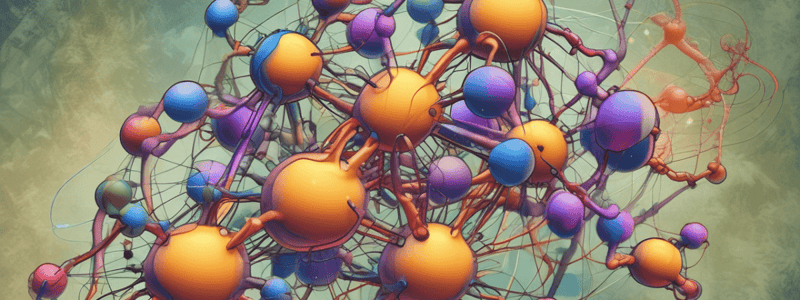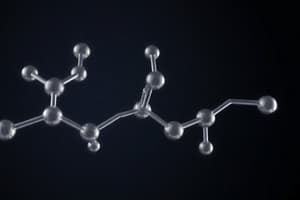Podcast
Questions and Answers
What type of inhibition occurs when the inhibitor forms a covalent adduct with the enzyme?
What type of inhibition occurs when the inhibitor forms a covalent adduct with the enzyme?
- Irreversible inhibition (correct)
- Non-competitive inhibition
- Mixed inhibition
- Competitive inhibition
Which enzyme inhibitor is mentioned in the text as an example of irreversible inhibition?
Which enzyme inhibitor is mentioned in the text as an example of irreversible inhibition?
- Magnesium hydroxide
- Organic phosphates
- Penicillin (correct)
- Glycoprotein peptidase
What happens when the concentration of substrate ([S]) increases concerning the inhibition by an inhibitor ([I])?
What happens when the concentration of substrate ([S]) increases concerning the inhibition by an inhibitor ([I])?
- Inhibition by [I] remains constant
- Inhibition by [I] decreases
- Inhibition by [I] increases (correct)
- Inhibition by [I] becomes irreversible
Which class of drugs acts on enzymes through simple chemical processes, according to the text?
Which class of drugs acts on enzymes through simple chemical processes, according to the text?
What term describes the gradual decrease in responsiveness to a drug, requiring larger doses to achieve the same effect?
What term describes the gradual decrease in responsiveness to a drug, requiring larger doses to achieve the same effect?
Which mechanism do osmotic laxatives and diuretics rely on to exert their effects?
Which mechanism do osmotic laxatives and diuretics rely on to exert their effects?
Which term describes compounds that bind but do NOT activate receptors?
Which term describes compounds that bind but do NOT activate receptors?
In reversible competitive antagonism, how do antagonists act?
In reversible competitive antagonism, how do antagonists act?
Which mechanism of antagonism involves the agonist binding to a site different from the ligand binding site?
Which mechanism of antagonism involves the agonist binding to a site different from the ligand binding site?
What happens in irreversible antagonism?
What happens in irreversible antagonism?
Which type of drug interaction involves passive transport across a cell membrane along its concentration gradient?
Which type of drug interaction involves passive transport across a cell membrane along its concentration gradient?
What is the primary effect of drug antagonists on endogenous agonists?
What is the primary effect of drug antagonists on endogenous agonists?
What mechanism typically leads to a gradual decrease in responsiveness to a drug?
What mechanism typically leads to a gradual decrease in responsiveness to a drug?
Which process can result in the active extrusion of a drug from cells?
Which process can result in the active extrusion of a drug from cells?
What type of inhibition involves the competitive binding of a molecule to the active site of an enzyme?
What type of inhibition involves the competitive binding of a molecule to the active site of an enzyme?
In drug interactions with transporters, what can lead to the active extrusion of the drug?
In drug interactions with transporters, what can lead to the active extrusion of the drug?
What is a common outcome of non-competitive enzyme inhibition?
What is a common outcome of non-competitive enzyme inhibition?
Which of the following can contribute to a decrease in drug efficacy over time?
Which of the following can contribute to a decrease in drug efficacy over time?
What is the direction of movement of a substance in active transport?
What is the direction of movement of a substance in active transport?
What is the result of a drug blocking calcium channels in the heart and smooth muscle?
What is the result of a drug blocking calcium channels in the heart and smooth muscle?
What is the mechanism of action of local anaesthetics on sodium channels?
What is the mechanism of action of local anaesthetics on sodium channels?
What type of interaction is involved in the blocking of channels by drug molecules?
What type of interaction is involved in the blocking of channels by drug molecules?
What type of transport is involved in the movement of substances against their concentration gradient?
What type of transport is involved in the movement of substances against their concentration gradient?
What is the target of drugs that act on transporters?
What is the target of drugs that act on transporters?
What is required for the transport of ions and larger molecules across the cell membrane against their concentration gradient?
What is required for the transport of ions and larger molecules across the cell membrane against their concentration gradient?
How do antidepressants affect the activity of neurotransmitters?
How do antidepressants affect the activity of neurotransmitters?
What is the mechanism of competitive inhibition?
What is the mechanism of competitive inhibition?
What is the effect of increasing the substrate concentration on competitive inhibition?
What is the effect of increasing the substrate concentration on competitive inhibition?
How do non-competitive inhibitors bind to the enzyme?
How do non-competitive inhibitors bind to the enzyme?
What is the main difference between competitive and non-competitive inhibition?
What is the main difference between competitive and non-competitive inhibition?




